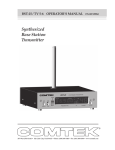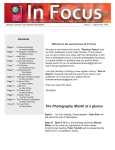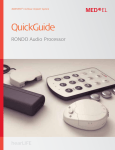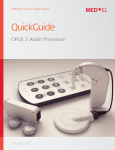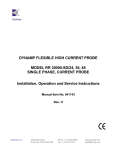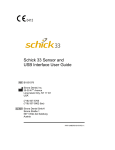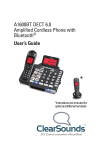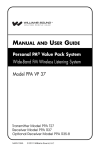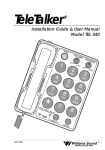Download Hearing Implants and the Classroom - Med-El
Transcript
Hearing Implants and the Classroom A Guide for Teachers First Day From the First Day Teaching pupils with different learning styles can it’s needed and continue to manage your be a challenge, but it’s one of the things that classroom well. makes your work interesting. When you found out that you’d have a pupil with a hearing implant, you What can you expect from this guide? First we’ll may have wondered if you’re prepared for this. have a look at how hearing implant systems work. What kind of support do children with hearing We’ll discuss how you can encourage your pupil’s implants need? How can you create the best academic skills and overall growth. You’ll learn to possible learning conditions for this pupil—and for anticipate situations that might present an extra everyone in your classroom? challenge and how to spot any signs that the hearing implant isn’t working. We’ll also show you If you’re trained to work with children with hearing some simple ways to improve classroom acoustics. loss, then you’ll be able to apply many of the principles you already use. If you don’t have any You’ll see that with some basic technical experience with hearing implants, such as a information, a little practice, and regular cochlear implant or bone conduction implant, communication with your pupil’s parents, you’ll don’t worry. By learning a few straightforward have everything you need to create a positive strategies, you’ll be able to provide support when learning environment for your whole class. 1 Hearing Implants Hearing Implant Systems Tools for Learning You may be familiar with hearing aids, but what Most hearing implant systems have two main are hearing implants and what can they do? For components—an external audio processor and an many people with hearing loss, hearing aids don’t internal implant. The audio processor is worn on or provide enough benefit. This is usually where off the ear and picks up sound in the environment. hearing implants come in. It’s the part that your pupil handles every day and may think of as his “ear.” A hearing implant system is a medical device that provides access to sound for people who have The audio processor is attracted to the implant mild-to-profound hearing loss and can’t wear by a magnet. The implant is positioned just under hearing aids. There are different types of hearing the skin and isn’t visible. The hearing implant implants for different kinds of hearing loss. system only works when the audio processor is turned on and connected with the implant. Each works in one of four ways: electrical stimulation, bone conduction, mechanical Hearing with a hearing implant is different than vibration, or a combination of electrical stimulation natural hearing; however, hearing implants have and acoustic amplification. Below we’ll take a brief provided hundreds of thousands of children with look at what all of them have in common. hearing and have helped them gain access to mainstream educational opportunities. Hearing Implant System Implant Audio Processor Auditory Nerve Hearing Loss and Early Development Watch our videos to find out how a hearing implant works www.medel.com As you may know, your pupil’s experience with a not be as full and clear as the sound that most of hearing implant is influenced by many factors. us hear. Because of these factors, children with His type and degree of hearing loss, his age at most types of hearing implants have to work implantation, the mode of language he uses harder on their speech perception, speech (spoken, signed, or both), and the amount of production, and phonological skills. practice he’s had will all shape his progress.1 His family’s expectations, and yours, are also really Despite these challenges, children who receive important. While you won’t be able to influence intervention during the sensitive period for all of these aspects, there are several ways you language development often catch up with their can encourage and support your pupil every day. peers. Many read at grade level and achieve It’s important to remember that your pupil’s speech skills and grades that are just as strong as those of their peers.2,3 Children with hearing cognitive and language skills might be affected by implants are going to mainstream schools in his hearing loss and his hearing implant. Your pupil increasing numbers, and they’re much more likely may not have had any auditory input for several months or more before he received his implant, to thrive when teachers and support staff are attentive to their needs.1 We’ve seen, and research so his auditory skills may be less developed. has shown, that with ongoing support from parents, clinicians, and educators like you, these children Cochlea Although he can now access sound, the auditory are doing well at home, in school, and beyond. information he receives through his implant may 2 3 STRATEGIES Creating Conditions for Success You’ll soon get a sense of your pupil’s learning style, and the training and experience you already have will guide you in making simple adjustments to lesson plans. In the meantime, what are the most meaningful things you can do to support your pupil? First, learn the basics of operating your pupil’s audio processors. Second, be aware of distractions and background noise. Minimise them whenever possible. Finally, keep in contact with your pupil’s parents and the therapists who support his development. Audio Processor Basics Whether or not you have a knack for technological Batteries devices, it’ll be very helpful to know some audio The audio processor batteries will most likely processor essentials. If your pupil is too young to outlast the school day, depending on the handle his processors, he’ll rely on you and other processor model and your pupil’s usage habits. teachers while he’s at school. But don’t worry. An To prevent your pupil from ever missing out on audio processor is no more difficult to work than a Daily check Preschoolers Especially if you have a young pupil, you may want If you teach preschool and your pupils take a nap to check the audio processors daily and learn how at school, you’ll want to help him with one extra to spot signs that the devices aren’t working. If step. To prevent damage to his processors, help your pupil seems less attentive than usual or him remove them before he lies down. Store the a lesson, you may want to ask the parents to isn’t responding to instructions or questions, processors in a safe place. Note that if your pupil mobile phone, and your pupil’s parents will gladly provide you with backup batteries. If you do empty batteries may be the culprit. If he ever has bilateral hearing loss (hearing loss in both give you a crash course in the basics. Consider change the batteries for your pupil, avoid resists wearing his processors, this could be a ears), he won’t be able to hear much, or anything asking them for a spare user manual, which you touching the battery contacts inside the battery sign that they aren’t working properly or that at all, when he’s not wearing his processors. Your can reference for more detailed information pack frame. there’s a problem with the audio processor pupil and his parents probably have a night-time program. Discuss any concerns with the routine for removing the processors, so the audiologist, if available, or the parents. parents may be able to share some tips about throughout the school year. Until then, this guide should be enough to get you started. Notifications Want more tips on audio processor handling? You’ll find troubleshooting tips and more on medel.com. Most audio processors have alert functions easing this transition. Overview such as indicator lights and acoustic signals. Other considerations An audio processor is a battery-operated device. These features are designed to indicate that the Find out whether your pupil’s processors are Your pupil’s hearing implant system works when processor is functioning properly. Your pupil’s water-resistant, waterproof, or neither. If the the audio processors are activated (turned on parents may have had these signals deactivated processors aren’t protected against water and they and connected to the implant) and the batteries because they don’t want their child’s processors get wet, they will likely get damaged. Take a few are charged and properly inserted. Keep in mind continually flashing or beeping. In such cases, the extra precautions if your pupil is involved in sports. that if your pupil’s audio processors fall off, he parents may devise their own methods for Before swimming lessons or other water activities, won’t be able to hear until the processors have checking processor function. Alert signals vary from remove the processors or use a waterproof been put back on. processor to processor, so check with the parents accessory. Make sure he wears a helmet before about the particulars of your pupil’s processors. playing sports that typically require one. 4 5 STRATEGIES In the Classroom You’re already used to adapting your teaching strategies and lesson plans to accommodate your pupils’ needs. What more can you do? Below are several classroom management tactics and other tips that are particularly suited for children with hearing loss. You probably already use some of these, and none will hamper the other pupils‘ learning. Some approaches may even help everybody. Classroom management: -- Speak clearly. -- Use visual aids to reinforce what you teach. -- Announce new topics on the whiteboard. -- Encourage your pupil to let you know when he hasn’t heard or understood. -- Don’t assume that your pupil will let on when he hasn’t understood. -- Check understanding by having your pupil rephrase what’s been said. -- Write down important information, such as homework assignments and due dates. -- Seat the child close to the spot where you do most of your teaching. -- If you play an audio recording, provide the pupil with a transcript. -- Before you show a video, offer a short summary. Use closed captioning. -- Avoid raising your voice unnecessarily. Raised voices and shouting distort speech and can impede understanding. -- Seat noisy pupils away from their peer with a hearing implant. -- Encourage questions. -- In case your pupil sometimes relies on lip reading, avoid standing directly in front of a light source when you talk. Questions & Answers My pupil has an implant for just one ear. Does this mean he can hear with only one ear? Most likely. If you’re not sure whether your pupil has binaural hearing loss (hearing loss in both ears) or single-sided deafness (hearing loss in only one ear), your pupil or the parents will be able to tell you. Hearing with only one ear takes additional mental resources, so children who can hear on only one side tend to have more difficulty concentrating and knowing where your voice or any other sounds are coming from. 6 7 STRATEGIES Improving acoustics: -- Attach felt or rubber to the bottom of chair legs to muffle the scrape of chairs being moved around. -- Place rugs around the room to absorb sound. -- Hang curtains to absorb sound and minimise reverberations. -- Close the classroom door to block noise from the corridor and other rooms. 8 9 Working Together Working Together Together with your pupil’s parents and the rehabilitation professionals who support him, you’ll play an essential role in ensuring he’s coping well with school.3 You can build the fullest possible picture of his strengths and challenges by working with his parents, speech therapist, audiologist, and other support staff throughout the school year. Partnering With Parents While you’re preparing for the upcoming school Throughout the school year, the parents should year, we encourage you to set up a meeting with let you know when their child’s audio processor your pupil’s parents. They’ll be able to familiarise program changes. The program affects the way a you with audio processor basics and they can pass hearing implant user processes and hears sound. on specific information about their child’s An audiologist will periodically reprogram your academic needs and abilities. Often, the parents pupil’s processor so he hears as well as possible, have been accompanying their child to therapy but these programming changes can initially sessions and, ideally, working on therapy goals at impact your pupil’s ability to process lessons home, so they’ll have insights about their child’s and pay attention. learning style. In turn, you can inform the parents of any changes in your pupil’s behaviour or attention. Professional Support Your pupil‘s audiologist, speech therapist, and opportunities to merge lesson plan objectives and teacher of the deaf are also invested in your therapy session goals. The speech therapist might pupil’s development, and can be very helpful in inquire about the content of your lesson plans; many aspects. When it comes to technical she may be able to integrate vocabulary words questions and audio processor functioning, the and other curriculum targets into therapy sessions. audiologist will be an expert resource. The She’ll assess—and may volunteer to discuss—your audiologist can also relay updates about changes pupil’s linguistic and communicative skills. These to your pupil’s program. insights may influence what you decide to reinforce with classwork or homework. You and your pupil‘s speech therapist or teacher of the deaf can collaborate by identifying 10 11 IMPROVING LISTENING Improving the Listening Experience Which sounds do you find the most distracting? The ringing of your mobile phone? The hum of traffic? For a child with a hearing implant, background noises can be particularly troublesome. In order to focus on important sounds, your pupil probably uses assistive listening devices (ALDs) with their hearing implant in certain situations. That means that you’ll want to get to know ALDs too. Assistive Listening Devices ALDs are devices that make it easier to focus on a banks, and taxi cabs—have hearing assistive particular sound source, such as music, a movie, technology available in place. Find out if your pupil or a teacher’s voice. They can help people with or your school has one of the following types of any degree of hearing loss. Because hearing loss is hearing assistive technology available. so common, many public places—such as cinemas, FM Systems Neckloops FM systems are portable wireless ALDs that A neckloop uses telecoil technology to wirelessly provide clear sound input, even from across a transmit sound to the wearer’s audio processor. room. These systems have two parts—a A neckloop may be able to directly connect to microphone transmitter and a receiver. audio devices, or may enable wireless streaming from a remote microphone. To use an FM system, you would wear the remote microphone on your clothing while your pupil will To use a neckloop in the classroom, you would clip wear a small receiver. When other pupils present a remote microphone onto your clothing while to the class, they should also use the remote your pupil wears a neckloop. Once he turns on the microphone. This type of system is a good choice telecoil setting of his audio processor, he can for classroom use, because it’s simple to use and focus more easily on your voice, which is picked it’s unlikely to cause interference. up by the microphone. Presenting pupils and other speakers should also use the remote microphone. Note that other electronic devices can cause distracting interference with neckloop systems. 12 13 Raising Expectations Raising Expectations Now you know how to check your pupil’s audio your pupil with hearing loss. Acknowledge his Looking Ahead processor. You’ve learned how to recognise and minimise noisy distractions in the classroom. unique strengths and challenges. Be flexible.1 Not everything we’ve discussed here will apply For more than thirty years, hearing implants As an educator, you’ll play an instrumental role You’ve had a crash course in ALDs and you’ve to your pupil, so trust your instincts. have been giving access to sound and speech in your pupil’s academic journey and lifelong personal growth. We hope this guide has given you help shape your pupil’s hearing and learning Some pupils do so well that teachers may forget to children who otherwise wouldn’t be able to hear a school bell, let alone a whisper.3 They’ve experiences. What more can you do to support that children with hearing implants don’t perceive expanded educational and social opportunities with a hearing implant, and we wish you a your pupil’s success? sound in exactly the same way as the rest of us.1,3 by making it possible for more of these children productive and successful school year ahead. If read about the other professionals that will insight into the experience of learning for a pupil Keep in mind that without your pupil’s audio to learn in a mainstream classroom and attend you have any questions, or would like to request When you set high expectations for your pupils processors, he’ll be able to hear little or nothing. school closer to home. educational materials for your classroom, please while providing all the tools and support they With them, he’ll still benefit tremendously from need, they’re much more likely to tackle difficult your ongoing support, your patience, and periodic tasks. Children with hearing implants and children evaluation by you and other professionals. contact us—we look forward to hearing from you. with typical hearing are much more alike than different, so hold the same high expectations for 14 15 References References 1. De Raeve, L. (2010). Education and rehabilitation of deaf children with cochlear implants: a multidisciplinary task. Cochlear Implants International 11(11): 7–14. doi: 10.1179/146701010X12671178390717 2. Spencer, L., Tomblin, J. B., Gantz, B. J. (2012). Growing up with a cochlear implant: education, vocation, and affiliation. Journal of Deaf Studies and Deaf Education 17(4). 483–498. No doi. 3. Lederberg, A. R., Schick, B., Spencer, P. E. (2013). Language and literacy development of deaf and hard-of-hearing children: successes and challenges. Developmental Psychology, 49(1), 15–30. doi: 10.1037/a0029558 16 17 MED-EL Offices Worldwide AMERICAS ASIA PACIFIC Argentina Australia Malaysia Austria Portugal Canada China Philippines Belgium Spain Colombia Hong Kong Singapore Finland South Africa Mexico India South Korea France United Arab Emirates United States Indonesia Thailand Germany United Kingdom Japan Vietnam Italy [email protected] [email protected] [email protected] [email protected] [email protected] [email protected] [email protected] [email protected] [email protected] [email protected] [email protected] EMEA [email protected] [email protected] [email protected] [email protected] [email protected] [email protected] [email protected] [email protected] [email protected] [email protected] [email protected] [email protected] [email protected] [email protected] [email protected] [email protected] [email protected] MED-EL Medical Electronics medel.com 24176 r2.0 Fürstenweg 77a | 6020 Innsbruck, Austria | [email protected]












